Kristine Hughes's Blog, page 121
August 23, 2012
Call For Papers!
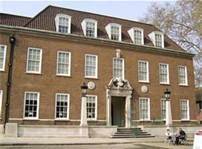 The 28th Annual Conference on Music in 18th-Century Britain will be taking place on Friday 30th November 2012 at the Foundling Museum, London. Offers of contributions to the programme are invited. We encourage proposals for presentations focusing on all aspects of music in 18th-century Britain. As well as formal papers we can accommodate formats such as round tables, reports on work-in-progress, lecture-recitals and performance. Proposals should be approximately 250 words. The length of the paper or presentation is normally limited to 30 minutes, but longer or shorter formats will be considered. Collaborative or related topic papers are also welcomed. Please submit your abstract by e-mail to c.sharpe@ram.ac.uk Be sure to include your name, address or institution, telephone, and email address in the body of the message. All submissions will be acknowledged by return email. Closing date for submissions is Friday 28 September.[image error]
The 28th Annual Conference on Music in 18th-Century Britain will be taking place on Friday 30th November 2012 at the Foundling Museum, London. Offers of contributions to the programme are invited. We encourage proposals for presentations focusing on all aspects of music in 18th-century Britain. As well as formal papers we can accommodate formats such as round tables, reports on work-in-progress, lecture-recitals and performance. Proposals should be approximately 250 words. The length of the paper or presentation is normally limited to 30 minutes, but longer or shorter formats will be considered. Collaborative or related topic papers are also welcomed. Please submit your abstract by e-mail to c.sharpe@ram.ac.uk Be sure to include your name, address or institution, telephone, and email address in the body of the message. All submissions will be acknowledged by return email. Closing date for submissions is Friday 28 September.[image error]
Published on August 23, 2012 23:56
August 22, 2012
Jane Austen in London
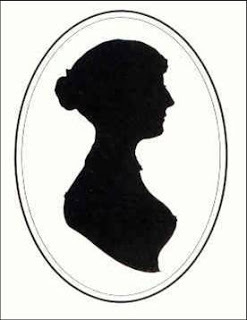
Jane Austen arrived at her brother Henry's new London residence in Hans Place on August 22, 1814. Henry had moved from his previous house in Henrietta Street near Covent Garden to this recently developed area off Sloane Street.
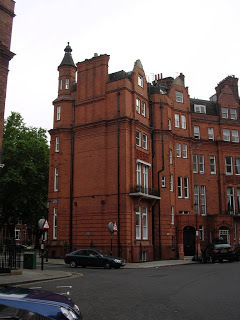
The house now occupying the spot at #23 Hans Place is a Victorian reconstruction, very unlike the house in which Austen stayed. Below, the blue plaque on the house, commemorating her stay on the premises.
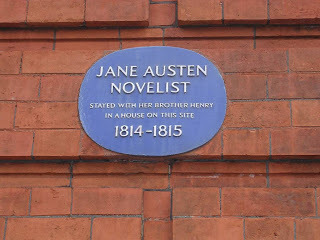
Around the crescent from #23 Hans Place there is a Regency-era house which is probably what Henry's house looked like in 1814. Of course, any vehicle that might have been in the road in those days would not have resembled the one here.
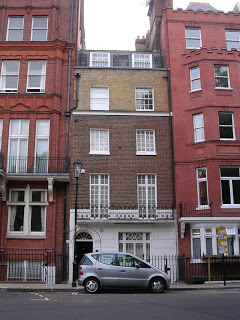
The neighborhood around Hans Place was relatively new, developed just off Sloane Street as part of the Cadogan estate and opened out onto uninhabited fields to the west. The Hans in the name honors to Sir Hans Sloane (1660-1753), president of the Royal Society and benefactor of the British Museum, for whom Sloane Square is named.
The general neighborhood has been much in the news lately because the Ecuadoran Embassy is located nearby, the place Julian Assange sought asylum.
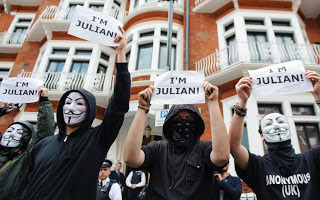
A quick check of property values in the area shows that these tall Victorian houses, now mostly institutions or condominiums, are extremely pricey.
Jane Austen described Henry's house in a letter to Cassandra dated Tuesday 23-Wednesday 24 August, 1814. After sharing a few details of her journey to London, she wrote: “It is a delightful place—more than answers my expectation. Having got rid of my unreasonable ideas, I find more space and comfort in the rooms than I had supposed and the Garden is quite a Love. I am in the front Attic, which is the Bedchamber to be preferred. Henry wants you to see it all…”
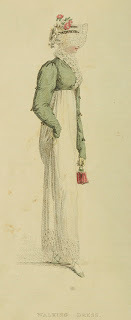 From Ackermann's Repository, April 1814
From Ackermann's Repository, April 1814In early September, Jane Austen wrote from London to Martha Lloyd, who was staying in Pulteney Street, Bath. She shares her impressions of London fashions: "I am amused by the present style of female dress; -- the coloured petticoats with braces over the white Spencers and enormous Bonnets upon the full Stretch are quite entertaining..."
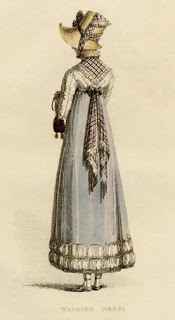 From Ackermann's Repository, 1814
From Ackermann's Repository, 1814Miss Austen went on to make observations on a recent art exhibit: "I have seen West's famous painting and prefer it to anything of the kind I ever saw before. I do not know that it is reckoned superior to his Healing in the Temple, but it has gratified me much more and indeed is the first representation of our Saviour which ever at all contented me. 'His Rejection by the Elders', is the subject.--I want to have You and Cassandra see it."
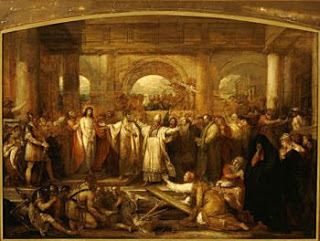 Benjamin West, Christ Rejected, 1814, Pennsylvania Academy of Fine Arts, Philadelphia
Benjamin West, Christ Rejected, 1814, Pennsylvania Academy of Fine Arts, PhiladelphiaJane Austen wrote further of her brother's house (his wife, Eliza de Feuillide Austen had died in April 1813): "I am extremely pleased with this new House of Henry's, it is everything that could be wished for him and I have only to hope he will continue to like it as well as he does now, and not be looking out for anything better.--He is in very comfortable health; -- he has not been so well, he says for a twelvemonth."
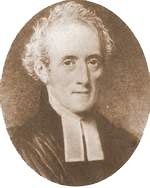
Henry Austen was his sister's favorite brother, for his talents and charm. He had several careers, first at Oxford, then in the military, and in various business ventures. His bank failed in 1816 and he went into the church, as curate in the Chawton parish and later as rector in Steventon. Henry assisted Jane in her publishing ventures, making deals for the sale and repurchase of her books. He oversaw posthumous publication of Jane Austen's Northanger Abbey and Persuasion.
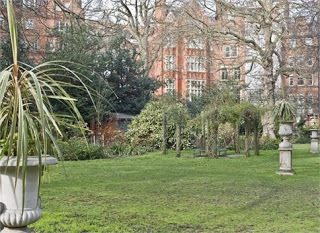 Today: Garden in Hans Place, London
Today: Garden in Hans Place, London[image error]
Published on August 22, 2012 01:00
August 20, 2012
A Sale at Fonthill
William Thomas Beckford (1760-1844) was one of the most intriguing, contradictory, and notorious men of his era. At age 10, he inherited an enormous fortune, mostly from West Indian plantations worked by slaves. For the rest of his life, he indulged his every whim, including travel, building fantastic structures, and acquiring works of art.
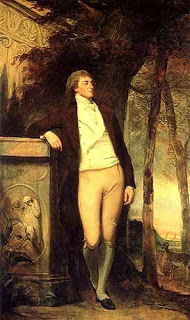 William Beckford, by George Romney,
William Beckford, by George Romney,
He also inherited his father's mansion, Fonthill Splendens, in Wiltshire; but it was not stupendous enough for Beckford, and he began building an amazingly tall (and insubstantial) new mansion nearby, which he called Fonthill Abbey.
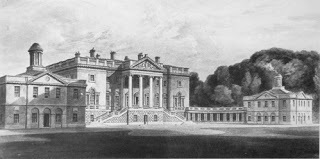 engraving of Fonthill Splendens
engraving of Fonthill Splendens
Just finished by his father about 1770, the Palladian-style mansion became the source of materials Beckford used to build the neo-Gothic Abbey --which was never part of the property of any religious body. Beckford largely destroyed Fonthill Splendens in the process.
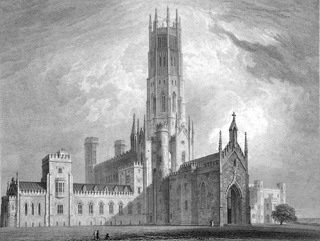 engraving of the completed Fonthill Abbey, about
engraving of the completed Fonthill Abbey, about
Architect James Wyatt began building Fonthill Abbey about 1796; it was not completed until 1813, after the main tower had collapsed several times during construction. Beckford continued throughout his lifetime to acquire art and in several sales, to sell it in order to buy more. In some cases, he later re-purchased items he sold. Here is an account of one of his large sales, disposing of art and furniture from Fonthill Splendens.
Fonthill sale, from the Chronicle in the Annual Register of 1801, p. 49-50:
"21 August. Fonthill. A brief account of this day’s sale will give a competent idea of the whole. There never was, perhaps, in the world, a collection of finer, or more superb furniture, in proportion to its quantity. The books, and a very few of the best paintings only, were retained. The Distinguished elegance of this noted feat, the natural beauty of the grounds, the art and expence so profusely lavished on their improvement; a spacious family mansion, in the best style of modern architecture, replenished with an excess of the most voluptuous accommodation, naturally attracted, as may well be conceived, all the fashion far and near. From Salisbury, Andover, Bath, Weymouth, etc. all the subordinate towns, the villas and even the hamlets, in their respective vicinities, the roads swarmed with the young and gay; and before noon every chamber in the house, as well as all the adjacent grounds, were crowded with genteel people; the court and stable yard with carriages, and all the gates, doors and passages, with the laqueys and beggars. The auction was in the great hall, where an organ, 26 feet high, and 15 feet wide, is placed. This very masterly instrument, built and finished in such superlative taste, that it is said to have cost near £2000 played till the business of the day commenced. Every article disposed of might, both for value and magnificence, suit any palace in Europe. Not a stool or tripod or spring blind or window curtain, was sold for so little as a guinea. Some marble slabs when at more than 100 guineas each. A bust of old Homer was knocked down at 27 guineas, that of Virgil at 19.
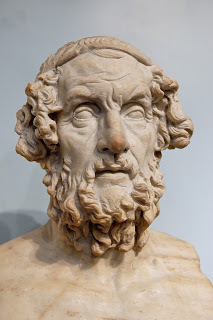 Copy of the Bust of Homer, British Museum
Copy of the Bust of Homer, British Museum
A young lady had inadvertently placed herself by a find statues of the Venus de Medicis. When this delicate and beautiful article was put up, a wag archly asked which of the two was meant? The auctioneer modestly replied, the one was above all price; and he was authorized only to dispose of the other.
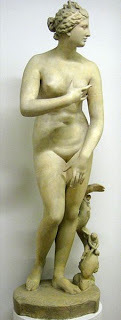 A version of Venus-di-Medici, now in Russia
A version of Venus-di-Medici, now in Russia
Everything in the room, fitted a la Turque, sold immensely high. The richness of the hangings, all silk or satin, of superlative quality, the brilliant French plates of glass which decorated and enlivened every side of the room, the sofas formed in the most sumptuous style of Oriental magnificence, the chairs and stools, all gilt with burnished gold, attracted every eye; and it was laughable to see even Wiltshire farmers furnishing their parlours with the gorgeous accumulation of inordinate fortune, and effeminate taste. Some articles, however, sold much under value. The organ went for no more than £290. It was purchased by the Rev. Mr. Ogle, brother-in-law to Mr. Sheridan."
Beckford sold Fonthill Abbey in 1823; the tower collapsed again in 1825. Today, only a small portion still stands.
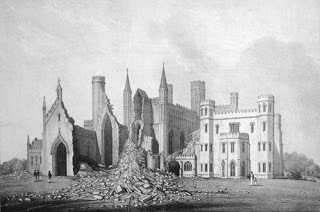
Beckford, also renowned for his authorship of the novel Vathek and other works, for his eccentric lifestyle, and his reclusive habits, moved to Bath, where he lived in conjoined townhouses in Lansdown Crescent and indulged in further tower building. The Lansdown or Beckford Tower can be visited in Bath today. For more information, click here.
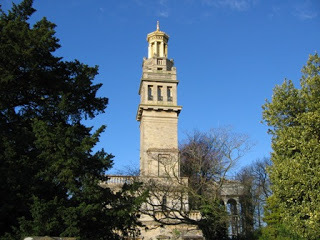 Beckford's Tower
Beckford's Tower
Paintings and decorative art works once owned by Beckford are now spread among the world's greatest collections. The painting below was once owned by Beckford and hung at Fonthill.
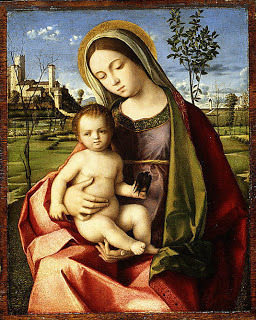 Madonna and Child, ca. 1510; workshop of Giovanni Bellini, Italian, active by 1459, died 1516Metropolitan Museum of Art, New York[image error]
Madonna and Child, ca. 1510; workshop of Giovanni Bellini, Italian, active by 1459, died 1516Metropolitan Museum of Art, New York[image error]
 William Beckford, by George Romney,
William Beckford, by George Romney, He also inherited his father's mansion, Fonthill Splendens, in Wiltshire; but it was not stupendous enough for Beckford, and he began building an amazingly tall (and insubstantial) new mansion nearby, which he called Fonthill Abbey.
 engraving of Fonthill Splendens
engraving of Fonthill SplendensJust finished by his father about 1770, the Palladian-style mansion became the source of materials Beckford used to build the neo-Gothic Abbey --which was never part of the property of any religious body. Beckford largely destroyed Fonthill Splendens in the process.
 engraving of the completed Fonthill Abbey, about
engraving of the completed Fonthill Abbey, about Architect James Wyatt began building Fonthill Abbey about 1796; it was not completed until 1813, after the main tower had collapsed several times during construction. Beckford continued throughout his lifetime to acquire art and in several sales, to sell it in order to buy more. In some cases, he later re-purchased items he sold. Here is an account of one of his large sales, disposing of art and furniture from Fonthill Splendens.
Fonthill sale, from the Chronicle in the Annual Register of 1801, p. 49-50:
"21 August. Fonthill. A brief account of this day’s sale will give a competent idea of the whole. There never was, perhaps, in the world, a collection of finer, or more superb furniture, in proportion to its quantity. The books, and a very few of the best paintings only, were retained. The Distinguished elegance of this noted feat, the natural beauty of the grounds, the art and expence so profusely lavished on their improvement; a spacious family mansion, in the best style of modern architecture, replenished with an excess of the most voluptuous accommodation, naturally attracted, as may well be conceived, all the fashion far and near. From Salisbury, Andover, Bath, Weymouth, etc. all the subordinate towns, the villas and even the hamlets, in their respective vicinities, the roads swarmed with the young and gay; and before noon every chamber in the house, as well as all the adjacent grounds, were crowded with genteel people; the court and stable yard with carriages, and all the gates, doors and passages, with the laqueys and beggars. The auction was in the great hall, where an organ, 26 feet high, and 15 feet wide, is placed. This very masterly instrument, built and finished in such superlative taste, that it is said to have cost near £2000 played till the business of the day commenced. Every article disposed of might, both for value and magnificence, suit any palace in Europe. Not a stool or tripod or spring blind or window curtain, was sold for so little as a guinea. Some marble slabs when at more than 100 guineas each. A bust of old Homer was knocked down at 27 guineas, that of Virgil at 19.
 Copy of the Bust of Homer, British Museum
Copy of the Bust of Homer, British MuseumA young lady had inadvertently placed herself by a find statues of the Venus de Medicis. When this delicate and beautiful article was put up, a wag archly asked which of the two was meant? The auctioneer modestly replied, the one was above all price; and he was authorized only to dispose of the other.
 A version of Venus-di-Medici, now in Russia
A version of Venus-di-Medici, now in RussiaEverything in the room, fitted a la Turque, sold immensely high. The richness of the hangings, all silk or satin, of superlative quality, the brilliant French plates of glass which decorated and enlivened every side of the room, the sofas formed in the most sumptuous style of Oriental magnificence, the chairs and stools, all gilt with burnished gold, attracted every eye; and it was laughable to see even Wiltshire farmers furnishing their parlours with the gorgeous accumulation of inordinate fortune, and effeminate taste. Some articles, however, sold much under value. The organ went for no more than £290. It was purchased by the Rev. Mr. Ogle, brother-in-law to Mr. Sheridan."
Beckford sold Fonthill Abbey in 1823; the tower collapsed again in 1825. Today, only a small portion still stands.

Beckford, also renowned for his authorship of the novel Vathek and other works, for his eccentric lifestyle, and his reclusive habits, moved to Bath, where he lived in conjoined townhouses in Lansdown Crescent and indulged in further tower building. The Lansdown or Beckford Tower can be visited in Bath today. For more information, click here.
 Beckford's Tower
Beckford's TowerPaintings and decorative art works once owned by Beckford are now spread among the world's greatest collections. The painting below was once owned by Beckford and hung at Fonthill.
 Madonna and Child, ca. 1510; workshop of Giovanni Bellini, Italian, active by 1459, died 1516Metropolitan Museum of Art, New York[image error]
Madonna and Child, ca. 1510; workshop of Giovanni Bellini, Italian, active by 1459, died 1516Metropolitan Museum of Art, New York[image error]
Published on August 20, 2012 01:00
August 17, 2012
Sefton's Commemorative Statue
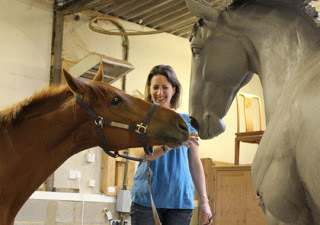
Recently, we wrote a post about Sefton, a Household Cavalry horse who was en route to the Changing of the Guard ceremony when he was wounded on 20 July 1982 by an IRA nail bomb that exploded in London’s Hyde Park killing four soldiers and seven horses. You can read the post here.
We thought you might like to know that Sefton is being remembered with a life size bronze statue to be unveiled Spring 2013. The statue is being created by artist Camilla Le May, who has written about the people who knew Sefton, the creative process and the assembly of the statue on her blog, found here.
You can also learn more about Sefton, a real life War Horse, on the National Army Museum's War Horse Exhibition website here.
[image error]
Published on August 17, 2012 00:32
August 14, 2012
The Death and Burial of Queen Caroline, Part II
Continuing the Accounts of the Death and Burial of Queen Caroline, August 1821
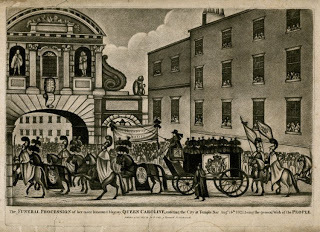 engraving of funeral procession of Caroline, August 14, 1821, British Museum
engraving of funeral procession of Caroline, August 14, 1821, British Museum
Caroline had long been a popular figure with the masses. During her funeral procession, riots broke out in the London streets.
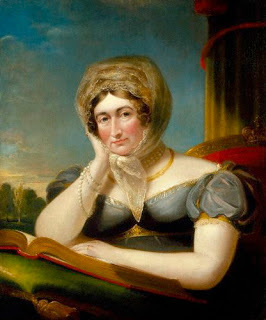 Queen Caroline, ca. 1821, by James LonsdaleNational Portrait Gallery, London
Queen Caroline, ca. 1821, by James LonsdaleNational Portrait Gallery, London
The following account was published in the Manchester Guardian on 18 August 1821:
"Before six o'clock a crowd assembled at Hyde Park Corner. The anxiety of the people as to the course the funeral procession [for Caroline of Brunswick] would take was here most strikingly displayed. The crowd were unwilling to depart from a place where there was a favourable chance of joining or viewing the procession; but there was the greatest agitation and alarm lest it should pass another way.
The procession reached Kensington at half past nine. It was after eleven that it moved on into Hyde Park, and an attempt was made to pass, but this failed, for the people, apprehensive that the hearse would not pass through the City, shut the gates.
About twelve o'clock the procession entered the Park, and during its passage through it a scene of confusion and outrage ensued of which the annals of this or any other Christian country can present few parallels. Vast numbers of persons on foot and on horseback passed with great speed along Park Lane. Their object was suspected by the Guards to be to reach that gate before them, with the view of meeting the procession, and forcing it to turn back. To prevent this, the Guards galloped through the Park to gain Cumberland Gate before them. The procession moved at a very quick pace through the Park. Suddenly, it halted, and it was understood that the people had closed the gates. It became necessary to force a way for the procession through whatever impediments might present themselves. The people were equally bent on turning the procession, and forcing it into the route of the city. Here a contest arose, and here, we deeply regret to say, blood was shed!
Some stones and mud were thrown at the military, and a magistrate being present, the soldiers were sanctioned in firing their pistols and carbines at the unarmed crowd. Screams of terror were heard in every direction. The number of shots fired was not less than forty or fifty. So completely did the soldiery appear at this period to have lost the good temper and forbearance they previously evinced, that they fired shots in the direction in which the procession was moving. Immediately upon the cessation of the firing, the latter part of the procession joined the rest of the funeral train. The rain, which had lately abated, again poured in torrents, as the procession advanced."
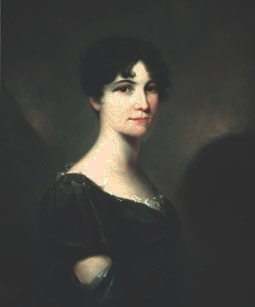 Harriet Arbuthnot, by John Hoppner
Harriet Arbuthnot, by John Hoppner
Harriet Arbuthnot, diarist and close friend of the Duke of Wellington wrote in her Journal:
"August 1821: 15th Most disgraceful riots have taken place in London at the Queen’s funeral. The people were dissatisfied at the procession being settled not to go thro’ the City and actually, by force and violence, by breaking up the roads and blocking them with carts and carriages, forced it into the City. One man was killed and many wounded, and nothing prevented a dreadful slaughter but the exemplary patience and forbearance of the military..."
A few days later, she wrote: " 21st – Mr. Arbuthnot writes me word from London that he thinks all the mischiefs at the Queen’s funeral were caused by Sir Robert Baker’s folly and cowardice, that the Riot Act was not read and the soldiers fired without orders; but, after all, men with arms in their hands cannot be expected to stand and be pelted to death without retaliating. Inquests are sitting upon the two men who were killed, and nothing ever was so absurd as the proceedings. Sheriff Waithman acts as Counsel for the dead men and treats the Coroner and everybody with the utmost impertinence; the Life Guards were paraded today that the witnesses might try and identify the man who fired, but all picked out different people and most of them men who were not on duty, so that it is quite a farce…"
On the 30th of August, Mrs. Arbuthnot wrote: "...There was a great riot at the Knightsbridge barracks at the funeral of the two men who were killed on the day of the Queen's funeral. The people hissed and hooted the soldiers and at last attacked one who was amongst them unarmed. His comrades defended him and a general battle ensured. Nobody was much hurt."
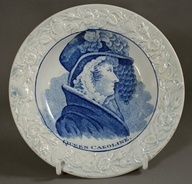 Memorial of Queen Caroline
Memorial of Queen Caroline
Mrs. Arbuthnot added a month later:
"Sept. 14 1821: The Duke of Wellington dined with us and told me that he was quite sure Sir Robert Wilson was at the bottom of whole riot at the Queen’s funeral. The Ministers have evidence that he offered five shillings to the first man who wd break up the roads, and gave beer to the mob to excite them; he also abused one of the soldiers and d----d him, on which the soldier loaded his pistol and cocked it, which preparation rather alarmed Sir Robert, and he made off. he is to be dismissed the Service as soon as the King returns, and he is expected today. I asked the Duke why he was not tried for treason for obstructing the King's Highway, but he said people were afraid of appearing as witnesses from the violence of the mob."
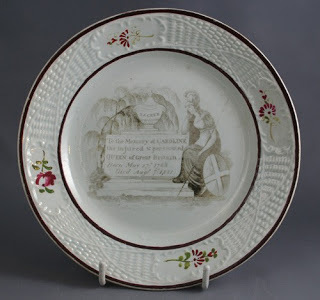 Another memorial to Queen Caroline
Another memorial to Queen Caroline
From the Hamburg papers, published September 5, 1821, in The Times:
"Brunswick, August 25: Yesterday was performed here the funeral ceremony of the entrance and depositing of the body of the late Queen of England, with all the solemnity and attachment to the House of their Princes which characterises the brave Brunswickers....The citizens of Brunswick...drew the car to the church themselves....Immediately behind it followed several hundred merchants and citizens with tapers. Behind the train of the citizens followed the carriages of the English, Alderman Wood, Lord Hood, Lady Hamilton, Austin, etc. and several carriages belonging to persons of this city attached to the House of Brunswick...There were 20,000 persons who followed the royal corpse, and the greatest tranquillity and order prevailed during the whole of the funeral solemnity. The church was hung with black, and 60 young ladies, all dressed in white with black sashes, received the corpse, and accompanied it, with wax tapers, to the vault. "
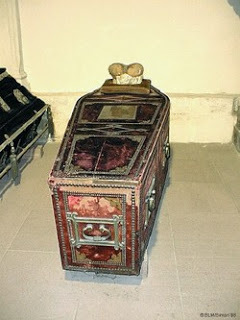 burial place of Caroline of Brunswick
burial place of Caroline of Brunswick
Caroline is buried in the Brunswick royal tomb in the cathedral in Brunswick (in German, Dom St. Blasii et Johannis), a large Lutheran church in the city now known as Braunschweig.
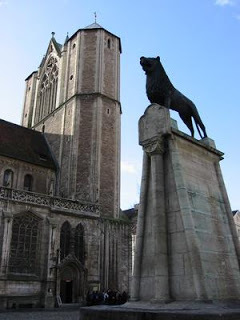 Cathedral of St. Blaise and St. John, Braunschweig, Germany
Cathedral of St. Blaise and St. John, Braunschweig, Germany
Numerous volumes have been published about the life of Caroline of Brunswick, her trials and tribulations. Below, the 1996 biography by Flora Fraser, published by Knopf.
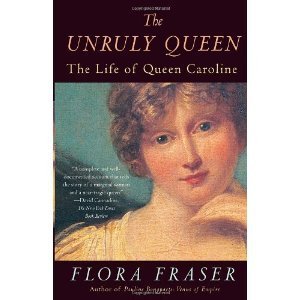
Ms. Fraser's conclusion (p.466): "[Caroline's] high-spirited, even reckless, response to her predicament brought her unprecedented liberty, as she confounded the machinations of her husband and of the governments in England and on the Continent to bring her to book. But in the end Caroline's breathtaking audacity had fatal consequences, contributing to the loss of her daughter, her crown and her life."
[image error]
 engraving of funeral procession of Caroline, August 14, 1821, British Museum
engraving of funeral procession of Caroline, August 14, 1821, British MuseumCaroline had long been a popular figure with the masses. During her funeral procession, riots broke out in the London streets.
 Queen Caroline, ca. 1821, by James LonsdaleNational Portrait Gallery, London
Queen Caroline, ca. 1821, by James LonsdaleNational Portrait Gallery, LondonThe following account was published in the Manchester Guardian on 18 August 1821:
"Before six o'clock a crowd assembled at Hyde Park Corner. The anxiety of the people as to the course the funeral procession [for Caroline of Brunswick] would take was here most strikingly displayed. The crowd were unwilling to depart from a place where there was a favourable chance of joining or viewing the procession; but there was the greatest agitation and alarm lest it should pass another way.
The procession reached Kensington at half past nine. It was after eleven that it moved on into Hyde Park, and an attempt was made to pass, but this failed, for the people, apprehensive that the hearse would not pass through the City, shut the gates.
About twelve o'clock the procession entered the Park, and during its passage through it a scene of confusion and outrage ensued of which the annals of this or any other Christian country can present few parallels. Vast numbers of persons on foot and on horseback passed with great speed along Park Lane. Their object was suspected by the Guards to be to reach that gate before them, with the view of meeting the procession, and forcing it to turn back. To prevent this, the Guards galloped through the Park to gain Cumberland Gate before them. The procession moved at a very quick pace through the Park. Suddenly, it halted, and it was understood that the people had closed the gates. It became necessary to force a way for the procession through whatever impediments might present themselves. The people were equally bent on turning the procession, and forcing it into the route of the city. Here a contest arose, and here, we deeply regret to say, blood was shed!
Some stones and mud were thrown at the military, and a magistrate being present, the soldiers were sanctioned in firing their pistols and carbines at the unarmed crowd. Screams of terror were heard in every direction. The number of shots fired was not less than forty or fifty. So completely did the soldiery appear at this period to have lost the good temper and forbearance they previously evinced, that they fired shots in the direction in which the procession was moving. Immediately upon the cessation of the firing, the latter part of the procession joined the rest of the funeral train. The rain, which had lately abated, again poured in torrents, as the procession advanced."
 Harriet Arbuthnot, by John Hoppner
Harriet Arbuthnot, by John HoppnerHarriet Arbuthnot, diarist and close friend of the Duke of Wellington wrote in her Journal:
"August 1821: 15th Most disgraceful riots have taken place in London at the Queen’s funeral. The people were dissatisfied at the procession being settled not to go thro’ the City and actually, by force and violence, by breaking up the roads and blocking them with carts and carriages, forced it into the City. One man was killed and many wounded, and nothing prevented a dreadful slaughter but the exemplary patience and forbearance of the military..."
A few days later, she wrote: " 21st – Mr. Arbuthnot writes me word from London that he thinks all the mischiefs at the Queen’s funeral were caused by Sir Robert Baker’s folly and cowardice, that the Riot Act was not read and the soldiers fired without orders; but, after all, men with arms in their hands cannot be expected to stand and be pelted to death without retaliating. Inquests are sitting upon the two men who were killed, and nothing ever was so absurd as the proceedings. Sheriff Waithman acts as Counsel for the dead men and treats the Coroner and everybody with the utmost impertinence; the Life Guards were paraded today that the witnesses might try and identify the man who fired, but all picked out different people and most of them men who were not on duty, so that it is quite a farce…"
On the 30th of August, Mrs. Arbuthnot wrote: "...There was a great riot at the Knightsbridge barracks at the funeral of the two men who were killed on the day of the Queen's funeral. The people hissed and hooted the soldiers and at last attacked one who was amongst them unarmed. His comrades defended him and a general battle ensured. Nobody was much hurt."
 Memorial of Queen Caroline
Memorial of Queen CarolineMrs. Arbuthnot added a month later:
"Sept. 14 1821: The Duke of Wellington dined with us and told me that he was quite sure Sir Robert Wilson was at the bottom of whole riot at the Queen’s funeral. The Ministers have evidence that he offered five shillings to the first man who wd break up the roads, and gave beer to the mob to excite them; he also abused one of the soldiers and d----d him, on which the soldier loaded his pistol and cocked it, which preparation rather alarmed Sir Robert, and he made off. he is to be dismissed the Service as soon as the King returns, and he is expected today. I asked the Duke why he was not tried for treason for obstructing the King's Highway, but he said people were afraid of appearing as witnesses from the violence of the mob."
 Another memorial to Queen Caroline
Another memorial to Queen CarolineFrom the Hamburg papers, published September 5, 1821, in The Times:
"Brunswick, August 25: Yesterday was performed here the funeral ceremony of the entrance and depositing of the body of the late Queen of England, with all the solemnity and attachment to the House of their Princes which characterises the brave Brunswickers....The citizens of Brunswick...drew the car to the church themselves....Immediately behind it followed several hundred merchants and citizens with tapers. Behind the train of the citizens followed the carriages of the English, Alderman Wood, Lord Hood, Lady Hamilton, Austin, etc. and several carriages belonging to persons of this city attached to the House of Brunswick...There were 20,000 persons who followed the royal corpse, and the greatest tranquillity and order prevailed during the whole of the funeral solemnity. The church was hung with black, and 60 young ladies, all dressed in white with black sashes, received the corpse, and accompanied it, with wax tapers, to the vault. "
 burial place of Caroline of Brunswick
burial place of Caroline of BrunswickCaroline is buried in the Brunswick royal tomb in the cathedral in Brunswick (in German, Dom St. Blasii et Johannis), a large Lutheran church in the city now known as Braunschweig.
 Cathedral of St. Blaise and St. John, Braunschweig, Germany
Cathedral of St. Blaise and St. John, Braunschweig, GermanyNumerous volumes have been published about the life of Caroline of Brunswick, her trials and tribulations. Below, the 1996 biography by Flora Fraser, published by Knopf.

Ms. Fraser's conclusion (p.466): "[Caroline's] high-spirited, even reckless, response to her predicament brought her unprecedented liberty, as she confounded the machinations of her husband and of the governments in England and on the Continent to bring her to book. But in the end Caroline's breathtaking audacity had fatal consequences, contributing to the loss of her daughter, her crown and her life."
[image error]
Published on August 14, 2012 01:00
August 12, 2012
The Death and Burial of Queen Caroline
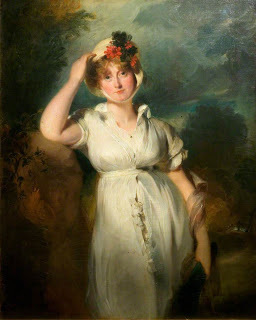 Princess Caroline of Brunswick, Princess of Wales, by Sir Thomas Lawrence, 1798Victoria and Albert Museum, London
Princess Caroline of Brunswick, Princess of Wales, by Sir Thomas Lawrence, 1798Victoria and Albert Museum, LondonThe married life and death of Queen Caroline (1768-1821 were equally frenzied. Though she was never officially crowned, Caroline of Brunswick-Wolfbuttel was the wife of King George IV and thus, Princess of Wales and after the 1820 death of George III, the Queen of England. She died on August 7, 1821, just a month after her husband's lavish coronation ceremony which she was physically restrained from attending.
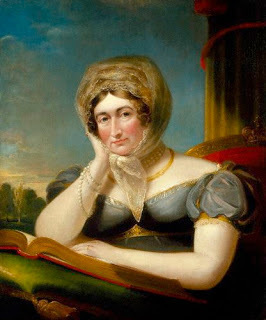 Queen Caroline, ca. 1821, by James LonsdaleNational Portrait Gallery, London
Queen Caroline, ca. 1821, by James LonsdaleNational Portrait Gallery, LondonFor an account of her death, we turn to excerpts from a letter from Viscount Hood to Henry Brougham, M.P., who had represented the Queen at her recent rial and had gone to York to attend Assizes.
" Brandenburgh House, 8th Aug., 1821.
". . . The melancholy event took place at 25 minutes past 10 o'clock last night, when our dear Queen breathed her last. Her Majesty has quitted a scene of uninterrupted persecution, and for herself I
think her death is not to be regretted. . . . She died in peace with all her enemies. Je ne mourrai sans
douleur, mais je mourrai sans regret (I shall not die without pain, but I die without regret) was frequently expressed by her Majesty. I never beheld a firmer mind, or any one with less feelings at the thought of dying, which she spoke of without the least agitation, and at different periods of her illness, even to very few hours of her dissolution, arranged her worldly concerns. . "
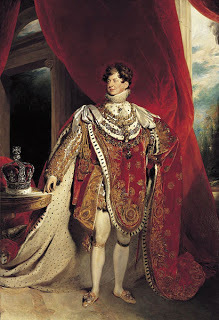 George IV in Coronation Robes, by Sir Thomas Lawrence, 1821
George IV in Coronation Robes, by Sir Thomas Lawrence, 1821King George IV learned the news of the death of his estranged -- and much despised -- wife while on board a ship bound for his visit to Ireland. Apparently illness had accomplished what he had tried to do so often in life -- rid himself of Caroline. Though there were rumors of poison and other nefarious plots, her death was officially ruled to be from natural causes. George IV greatly resented the popular acclaim that Caroline enjoyed; she was a favorite of the people; they probably loved her mainly because they detested the Prince Regent/King and his profligate ways.
Even in death, Caroline left controversy in her wake, as expressed by our old friend, the Diarist Thomas Creevey:
Mr. Creevey to Miss Ord.
"Cantley, Aug. 11.
. . . The death of this poor woman under all its circumstances is a most striking event and gave me an
infernal lump in my throat most part of Thursday. . . . (There) is one subject which gives me some uneasiness in the making of her will, the Queen wished to leave some diamonds to Victorine, the child of Pergami, of whom she was so fond. This was not liked by Brougham and her other lawyers, so the bequest does not appear in the will ; but the jewels are nevertheless to be conveyed to Victorine. This, you know, is most delicate matter to be employed on her deathbed in sending her jewels from Lady Anne Hamilton and Lady Hood to Pergami's child appears to me truly alarming. I mean, should it be known, and one is sure it will be so, for Taylor had a letter from Denison last night mentioning such a report, and being quite horrified at it. On the other hand, when I expressed the same sentiment to Brougham, he thought nothing of it. His creed is that she was a child-fancier: that Pergami's elevation was all owing to her attachment to Victorine, and he says his conviction is strengthened every day of her entire innnocence as to Bergami. This, from Brougham, is a great deal, because I think it is not going too far to say that he absolutely hated her; nor do I think her love for her Attorney General (Brougham) was very great."
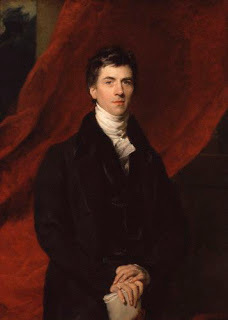 Henry Brougham ( 1778-1868)advisor and attorney to Caroline, later Lord Chancellor of GBby Sir Thomas Lawrence, 1825
Henry Brougham ( 1778-1868)advisor and attorney to Caroline, later Lord Chancellor of GBby Sir Thomas Lawrence, 1825Creevey is referring to Victorine, the daughter of Caroline's companion and perhaps lover, Pergami. She was one of several children Caroline doted upon during her lifetime, Whether any of them were her illegitimate offspring was widely discussed but never proved. Several were left legacies in her will.
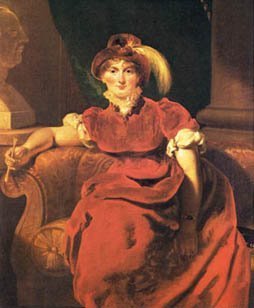 Caroline, Princess of Wales, by Sir Thomas Lawrence, 1804, NPG
Caroline, Princess of Wales, by Sir Thomas Lawrence, 1804, NPGGeorge IV was desperate to rid himself of his wife. They had been estranged since shortly after their arranged marriage in 1795, even before the birth of their only child, Princess Charlotte of Wales (1796-1817). Even after Charlotte's lamented death in childbirth, Caroline had remained abroad, living in Italy until her husband became king. But when she returned to England, she faced an unpleasant situation.
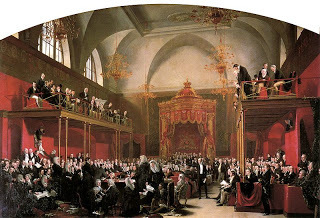 Trial of Queen Caroline by Sir George Hayter, NPG
Trial of Queen Caroline by Sir George Hayter, NPGWhen King George tried to divorce his wife in a trial before the House of Lords in 1820, Henry Peter Brougham (1778–1868), later 1st Baron Brougham and Vaux, defended her. The fact that the case was later dropped gave him great prestige. He became Lord Chancellor of Great Britain under King William IV.
Letter from Henry Brougham, M.P., to Mr. Creevey.
"Aug. 14, 1821.
DEAR C,
I have seen Lushington and Wilde repeatedly. They are at this moment in negociation with the Govt. ; or rather throwing up all concern with the funeral on account of this indecent hurry. Their ground is a clear one : they won't take charge of it from Stade the port in Hanover to Brunswick without knowing that arrangements are ready to receive them. . . . The Govt., only wishing the speedy embarkation, as they avow, for the sake of not delaying the dinner at Dublin, insist on getting it on board as quick as possible, and don't mind what happens afterwards. ... I shall, I think, be satisfied with going to Harwich with it, and not go, as I had intended, to Brunswick."
Poor Caroline. Though the people mourned her, only those required to accompany her body apparently wanted to do so. She had requested burial in her native Brunswick.
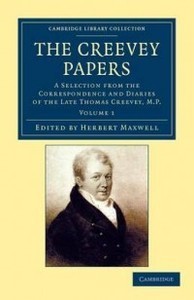
Mr. Creevey to Miss Ord.
" Cantley, Aug. 18th.
". . . Here is Brougham again. He has been at Harwich, where he saw the body of the Queen embarked about 3 o'clock on Thursday; and then immediately came across the country, and, after travelling all night, got here to dinner yesterday, and proceeds to Durham to-night to join the circuit there. I wish very much I had been at Harwich : according to Brougham's account it must have been the most touching spectacle that can be imagined the day magnificently beautiful the sea as smooth as glass
our officers by land and sea all full dressed soldiers and sailors all behaving themselves with the most
touching solemnity the yards of the four ships of war all manned the Royal Standard drooping over
the coffin and the Queen's attendants in the centre boat every officer with his hat off the whole time minute guns firing from the ships and shore, and thousands of people on the beach sobbing put aloud. ... It was as it should be and the only thing that was so during the six and twenty years' connection of this unhappy woman with this country. . . And now what do you think Brougham said to me not an hour ago? that if he had gone with the Queen's body to Brunswick, it would have been going too far it would have been over-acting his part ; ' it being very well known that through the whole of this business he had never been very much for the Queen ! ' Now upon my soul, this is quite true, and, being so, did you ever know anything at all to equal it ?"
Apparently Mr. Creevey did not approve of Mr. Brougham's dismissal of any affection for the lady he had served as adviser since 1812.
 engraving of funeral procession of Caroline, August 14, 1821, British Museum
engraving of funeral procession of Caroline, August 14, 1821, British MuseumCaroline had long been a popular figure with the masses. During her funeral procession, riots broke out in the London streets. We will continue reporting on Queen Caroline's death and burial soon.
[image error]
Published on August 12, 2012 01:00
August 10, 2012
Britain on Display: the Olympic Jumps
Hooray for the British featuring some of their great accomplishments throughout history not only in the opening ceremonies, but also in the venues and especially in the Olympic Show Jumping Competition.
It was great fun to watch the beach volleyball at Horse Guards, wasn't it?

We are more used to seeing the parade grounds at Horse Guards at the Trooping of the Colour.
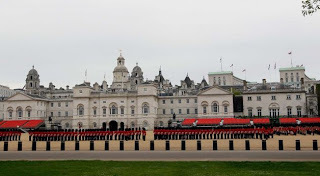 Horse Guards Parade, Trooping the Colour
Horse Guards Parade, Trooping the Colour
The Arena for the Olympic Equestrian Events was held on the grounds of the Queen';s House, Greenwich, below the Greenwich Observatory.
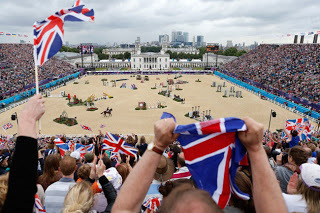
Usually, this area is a lawn and so it will be after the Olympics, the organizers assure us.
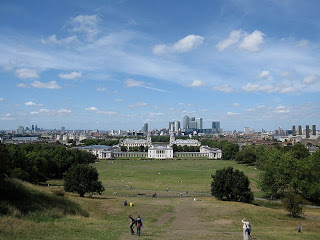 Queen's House and skyline from the Greenwich Observatory
Queen's House and skyline from the Greenwich Observatory
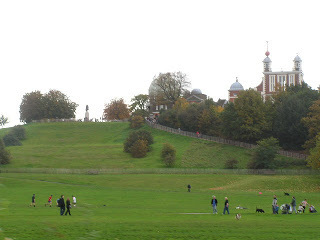 Greenwich Observatory from the bottom of the hill
Greenwich Observatory from the bottom of the hill
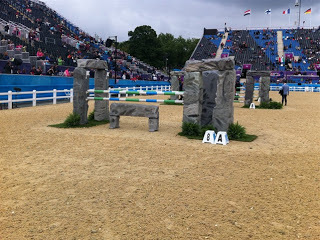 Stonehenge Jump
Stonehenge Jump
Course Designer Bob Ellis and his team put together a wonderful array of obstacles for the show jumpers, all of which displayed an aspect of British history.
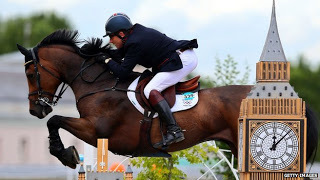 Big Ben is a natural!
Big Ben is a natural!
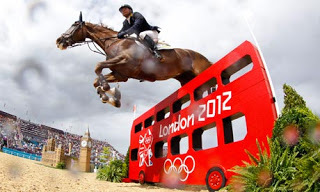 What is more iconic than a London bus, especially in the rain???
What is more iconic than a London bus, especially in the rain???
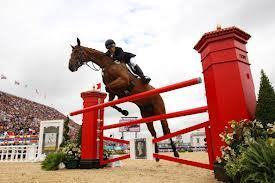 And the Royal Mail pillar-style post boxes are seen all over Britain.
And the Royal Mail pillar-style post boxes are seen all over Britain.
 Honoring Charles Darwin
Honoring Charles Darwin
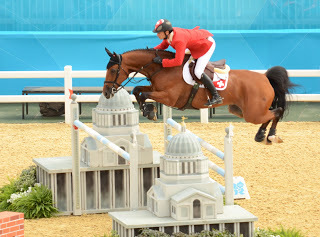 The site itself was honored, with the old Royal Naval Hospitals and the Queen's House underneath the horse
The site itself was honored, with the old Royal Naval Hospitals and the Queen's House underneath the horse
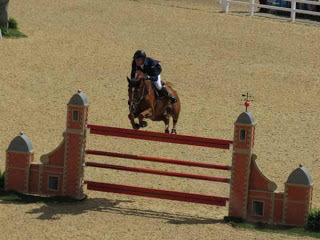 Greenwich Observatory and the Prime Meridian
Greenwich Observatory and the Prime Meridian
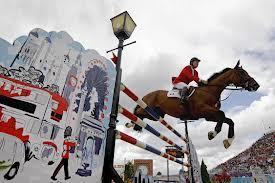 A London Panorama
A London Panorama
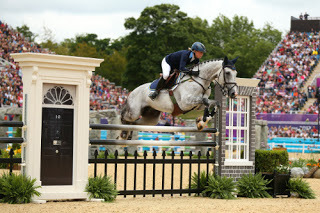 Number 10 Downing Street
Number 10 Downing Street
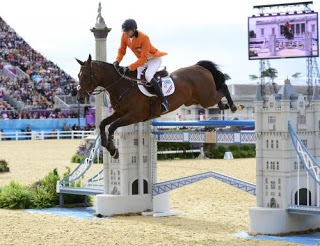 Tower Bridge
Tower Bridge
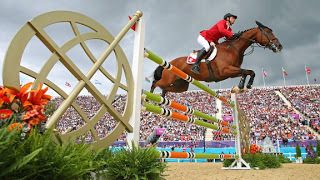 Many jumps were designed to honor various maritime achievements.
Many jumps were designed to honor various maritime achievements.
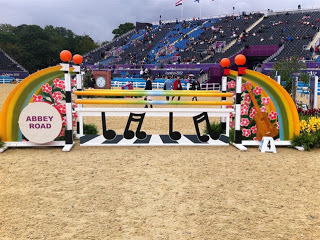 Abbey Road and the Beatles
Abbey Road and the Beatles
To see more of the clever jumps and to read about the creators, click here. My favorite course is here. Then scroll down to my favorite, Fence Six. Stupendous!!
Finally Congratulations to the superb equestrians of Team GB:
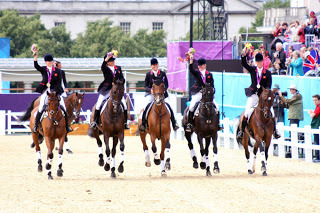 Eventing Team: Silver
Eventing Team: Silver
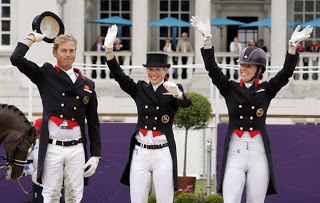 Dressage Team: Gold
Dressage Team: Gold
 Show Jumping: Gold
Show Jumping: Gold
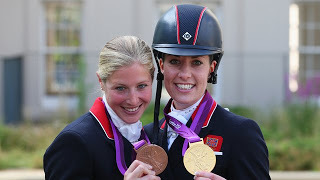
Individual Dressage, Laura Bechtolsheimer, GB (bronze), Gold Medal Winner Charlotte Dujardin, GB
It was great fun to watch the beach volleyball at Horse Guards, wasn't it?

We are more used to seeing the parade grounds at Horse Guards at the Trooping of the Colour.
 Horse Guards Parade, Trooping the Colour
Horse Guards Parade, Trooping the ColourThe Arena for the Olympic Equestrian Events was held on the grounds of the Queen';s House, Greenwich, below the Greenwich Observatory.

Usually, this area is a lawn and so it will be after the Olympics, the organizers assure us.
 Queen's House and skyline from the Greenwich Observatory
Queen's House and skyline from the Greenwich Observatory Greenwich Observatory from the bottom of the hill
Greenwich Observatory from the bottom of the hill Stonehenge Jump
Stonehenge JumpCourse Designer Bob Ellis and his team put together a wonderful array of obstacles for the show jumpers, all of which displayed an aspect of British history.
 Big Ben is a natural!
Big Ben is a natural! What is more iconic than a London bus, especially in the rain???
What is more iconic than a London bus, especially in the rain??? And the Royal Mail pillar-style post boxes are seen all over Britain.
And the Royal Mail pillar-style post boxes are seen all over Britain. Honoring Charles Darwin
Honoring Charles Darwin The site itself was honored, with the old Royal Naval Hospitals and the Queen's House underneath the horse
The site itself was honored, with the old Royal Naval Hospitals and the Queen's House underneath the horse Greenwich Observatory and the Prime Meridian
Greenwich Observatory and the Prime Meridian A London Panorama
A London Panorama Number 10 Downing Street
Number 10 Downing Street Tower Bridge
Tower Bridge Many jumps were designed to honor various maritime achievements.
Many jumps were designed to honor various maritime achievements. Abbey Road and the Beatles
Abbey Road and the BeatlesTo see more of the clever jumps and to read about the creators, click here. My favorite course is here. Then scroll down to my favorite, Fence Six. Stupendous!!
Finally Congratulations to the superb equestrians of Team GB:
 Eventing Team: Silver
Eventing Team: Silver Dressage Team: Gold
Dressage Team: Gold Show Jumping: Gold
Show Jumping: Gold
Individual Dressage, Laura Bechtolsheimer, GB (bronze), Gold Medal Winner Charlotte Dujardin, GB
Published on August 10, 2012 01:00
August 8, 2012
Kenwood House: Traveling Treasures
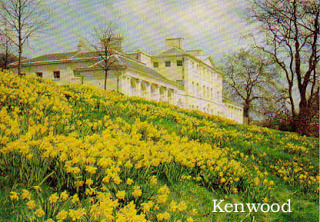 Early Spring at Kenwood House
Early Spring at Kenwood HouseVictoria here, recalling several visits to Kenwood House, a beautiful white mansion sitting atop Hampstead Heath just outside of central London. Originally built in the early 17th century, it was remodeled by Robert Adam 1764-1779 in the neoclassic style with Adam's distinctive and oft-copied interiors.
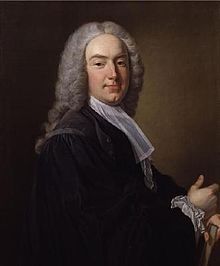 1st Earl of Mansfield (1705-1793)
1st Earl of Mansfield (1705-1793)At the time, it was owned by William Murray, who was named Baron Mansfield, later 1st Earl of Mansfield. He was the Lord Chief Justice from 1756 to 1788 and is credited with major contributions to the development of English law as well as measures to end slavery in the British Isles.
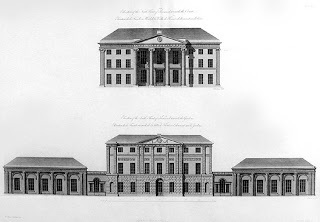 Elevations of Kenwood House, 1764
Elevations of Kenwood House, 1764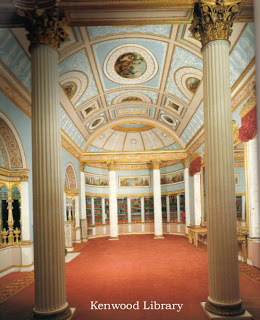 The famous Library
The famous LibraryIn 1925, Edward Cecil Guinness, 1st Earl of Iveagh (1847-1927) and heir to a brewery fortune, bought the house from the Mansfield heirs as the home for his magnificent collection of art. At Iveagh's death in 1927, he left both the house and the art collection to the nation. It is also known as the Iveagh Bequest.
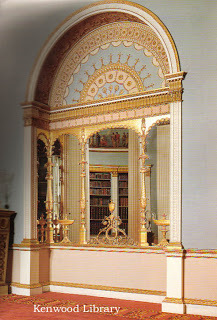
Now managed by English Heritage, Kenwood House is undergoing extensive renovations and improvements, returning many rooms to their appearance after Robert Adam decorated them, probably to match the library, which has been long admired by visitors.
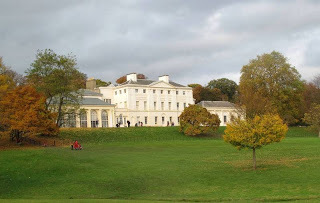
In 2012-13 an exhibition of works from the collection Rembrandt, Van Dyck, Gainsborough: The Treasures of Kenwood House, London is touring museums in the United States while Kenwood House is closed. Many of the works have never before been outside Britain. The treasured Rembrandt Self-Portrait was exhibited at the Metropolitan Museum of Art briefly in spring before the whole exhibition opened at the Fine Arts Museum of Houston, Texas, where it can been seen until September 3, 2012.
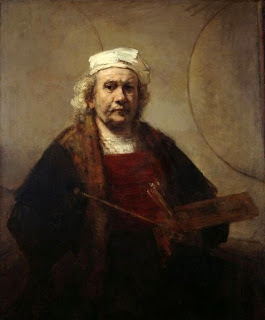 Self Portrait, Rembrandt van Rijn, 1661
Self Portrait, Rembrandt van Rijn, 1661I am particularly excited because the collection will next travel to the Milwaukee Art Museum (practically in my front yard) from October 12, 2012 through January 13, 2013. After Milwaukee, the collection will be shown in Seattle and later yet at the Arkansas Art Center.
The other artists celebrated in the title of this traveling exhibition include Anthony van Dyck (1599-1641) who painted numerous portraits of English royalty and aristocrats.
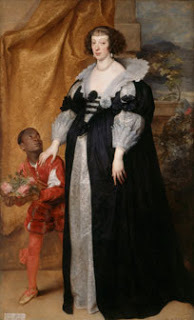 Princess Henrietta of Lorraine attended by a Page, 1634
Princess Henrietta of Lorraine attended by a Page, 1634Thomas Gainsborough (1727-1788) is renowned for his exquisite portraits, and this one is among his best.
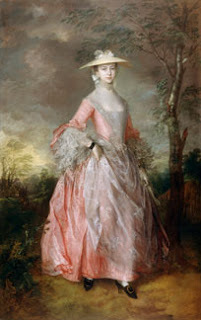 Mary, Countess of Howe, c. 1764
Mary, Countess of Howe, c. 1764Many other masterworks are included in the nearly fifty paintings in the exhibition by artists such as Canaletto, Sir Joshua Reynolds, Sir Thomas Lawrence, Sir Edwin Landseer, and...
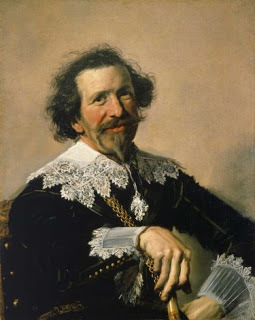 Portrait of Pieter van der Broecke, by Frans Hals, 1633
Portrait of Pieter van der Broecke, by Frans Hals, 1633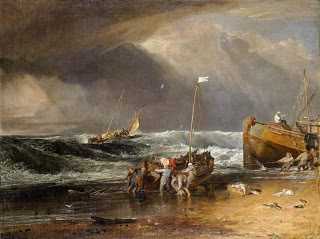 Joseph Mallord William Turner, A Coast Scene with Fisherman Hauling a Boat Ashore, c. 1803-04
Joseph Mallord William Turner, A Coast Scene with Fisherman Hauling a Boat Ashore, c. 1803-04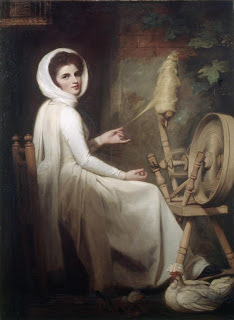 George Romney, Emma Hart as The Spinstress, c. 1783-84
George Romney, Emma Hart as The Spinstress, c. 1783-84The exhibition Rembrandt, van Dyck and Gainsborough: Treasures from Kenwood House is organized by The American Federation of Art and English Heritage.


Published on August 08, 2012 01:00
August 6, 2012
A Visit to Salisbury Cathedral
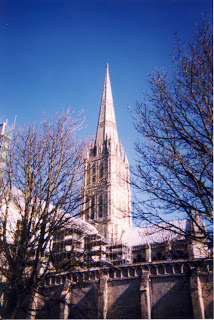
Approaching the Salisbury Cathedral, the magnificent spire seems to pierce the blue canopy above, reaching for the heavens. It is Britain's highest at 404 feet, and certainly the most graceful. The Cathedral's website is here.
Officially named the Cathedral Church of the Blessed Virgin Mary, it is more than 750 years old, completed in 1258, after just 38 years of construction, almost a miracle in the day. The rapidity of completion also ensured that Salisbury Cathedral is basically one style, the Early English Gothic; many cathedrals had several generations of builders involved, bringing evolving styles to their construction.
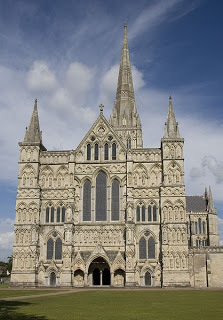 The West Front
The West FrontThe tower and spire were added somewhat after the main structure was finish. Visitors may climb the 330-plus steps into the tower to the base of the spire, which gives an excellent view of the interior construction of medieval days.
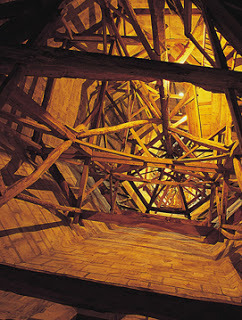 Interior of the spire
Interior of the spireThough art and religious historians have tried to explain to the contemporary visitor just what a cathedral was, its symbolic role and its functions as a religious and community center, it is difficult for us to grasp just what these amazing buildings meant in medieval society.

The novel Pillars of the Earth by Ken Follett provides a fictional account of the building of a great cathedral, roughly based on Salisbury. It was presented as a television miniseries in 2010, and it is well worth watching.
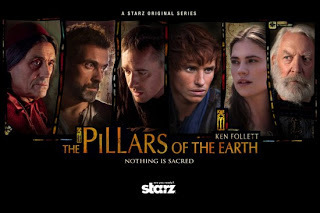
In addition to the book and tv versions, an expanded and amplified interactive editions is available for download to your iPad or other mobile device. For a preview, click here.

Novelist Susan Howatch also set a series of novels in the cathedral community of Starbridge, also modeled on Salisbury, though in the 20th century. There are six novels in the series, beginning with Glittering Images.
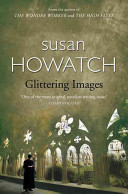
Salisbury Cathedral, with the largest cathedral close (precinct) in England and also the largest cloister, is a major tourist attraction in Wiltshire, competing with the nearby stone circles at Stonehenge and Avebury, Old Sarum, stately homes such as Wilton House and Bowood, the Safari Park at Longleat, and extensive gardens such as at Stourhead. In addition to the building and its art, one of four existing copies of the Magna Carta is on exhibit in the Cathedral's Chapter House.
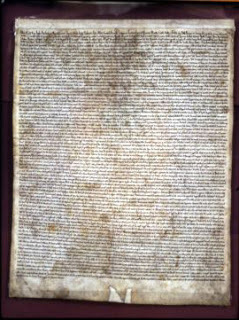
The Magna Carta was signed in 1215 by King John; it provides a foundation for democratic values in removing absolute power from kings and providing for liberty under the law.
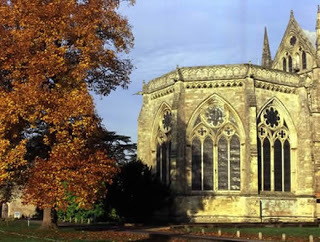 The Chapter House, from the South
The Chapter House, from the South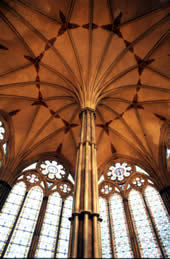 The Central Pillar and fan vaulting of the Chapter House
The Central Pillar and fan vaulting of the Chapter HouseJohn Constable, brilliant painter -- particularly of landscapes -- painted Salisbury Cathedral many times. Versions exist in many of Britain's major museums as well as in several in the U.S.
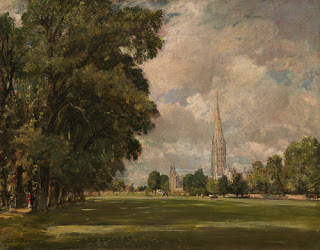 Salisbury Cathedral from Lower Marsh Close, 1820Artist: John Constable (1776-1837), Andrew W. Mellon CollectionCopyright © 2012 National Gallery of Art, Washington, DC
Salisbury Cathedral from Lower Marsh Close, 1820Artist: John Constable (1776-1837), Andrew W. Mellon CollectionCopyright © 2012 National Gallery of Art, Washington, DC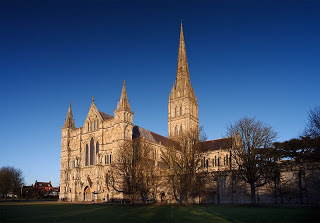 Salisbury Cathedral from the southwest
Salisbury Cathedral from the southwest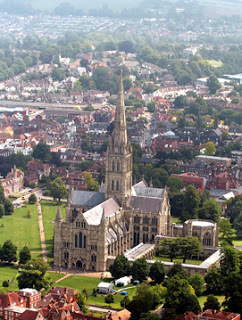 Aerial View
Aerial View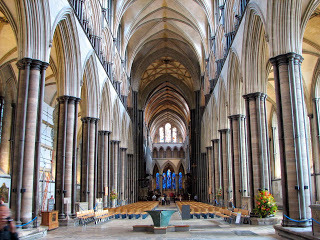 The Nave -- from the altar
The Nave -- from the altarIn addition to the Magna Carta, the Cathedral's architecture and art works, the chapels and tombs, monuments and carvings, you will also find the oldest clock in Europe.
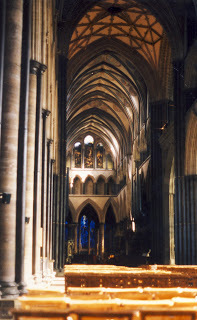 another view of the nave
another view of the naveWe are accustomed to seeing the stonework in old churches elaborately carved but merely gray, monochromatic stone. However, originally most of these walls and ceilings were elaborately painted. At Salisbury, many of these ancient decorations have been restored or replaced.
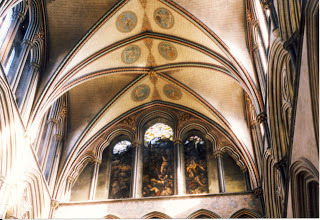
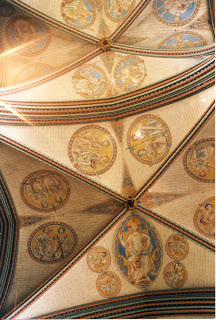
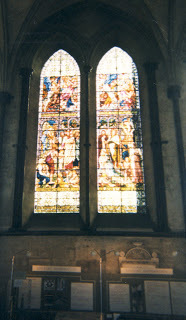 Many of the windows date from the Victorian era; others are much older.
Many of the windows date from the Victorian era; others are much older.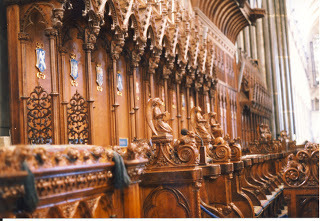 The beautifully carved choir
The beautifully carved choir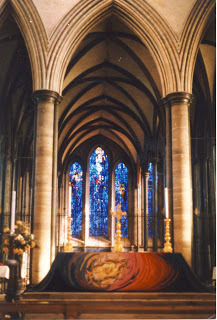
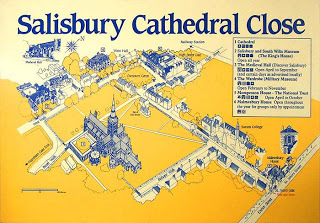
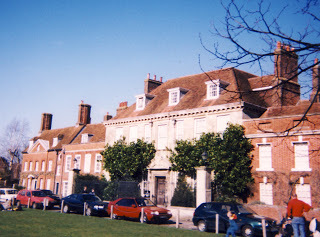 Mompesson House in the Close, run the by National TrustFeatured as the London home of Mrs. Jennings in the Ang Lee-Emma Thompson 1995 film of Jane Austen's Sense and Sensibility
Mompesson House in the Close, run the by National TrustFeatured as the London home of Mrs. Jennings in the Ang Lee-Emma Thompson 1995 film of Jane Austen's Sense and Sensibility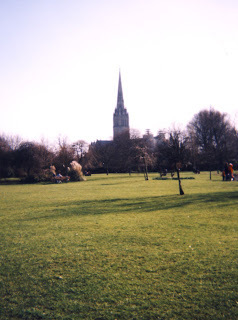 Across the Water Meadows
Across the Water MeadowsMost pictures from the Cathedral Website or by my sister-in-law, Patricia Biggers
Published on August 06, 2012 01:00
August 4, 2012
Britain Magazine: the Official Guide
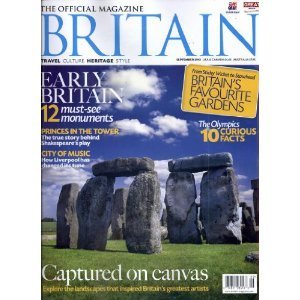 September 2012 issue
September 2012 issueVictoria here, writing again about favorite magazines. Besides watching the BBC news and listening too, via public stations here in the U.S., I stay close to Britain while I am home by reading lots of magazines, many from the UK. Every two months, Visit Britain, the official tourism agency, publishes a glossy issue filled with travel suggestions, sumptuous pictures and tempting ads, aka gift ideas. Sigh.

The latest issue to arrive is dated September 2012 and has many interesting articles, from ice age cave-dwellers to the Princes in the Tower to this summer's favorite gardens.
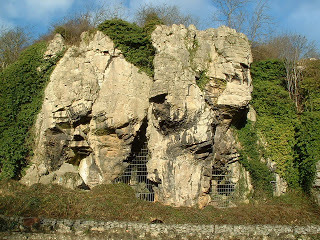 Creswell Crags
Creswell Crags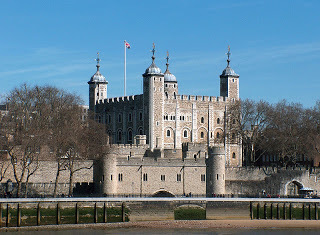 Tower of London
Tower of London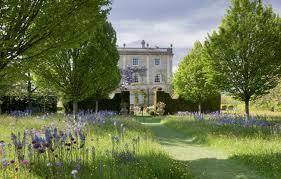 Highgrove House and Gardens
Highgrove House and GardensIt's a wonderful mix of history and scenery, castles and stately homes, villages and cities. The website, too, is excellent and could occupy you for a long afternoon of dreaming, here. Subscriptions are available and the magzine can be found in most bookstores and newstands.
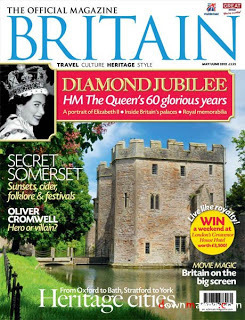 July 2012 issue
July 2012 issueAs you might have expected, the July issue of Britain had a major feature on The Diamond Queen, to celebrate Elizabeth II's sixty years on the throne.
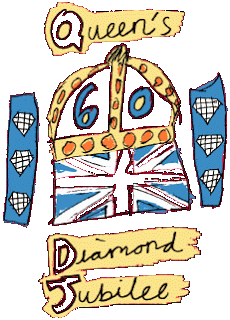
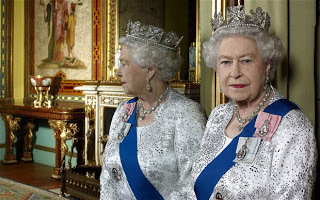
Other topics were the county of Somerset (Land of the Summer People), Royal Memorabilia, Inside Britain's Palaces, and Britian's Most Eccentric Events. You can read the latter here.
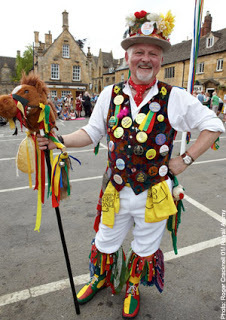 A Morris Dancer in Chipping Campden
A Morris Dancer in Chipping CampdenYou also have the opportunity to win weekends at posh hotels and tours -- and if your letter to the magazine is chosen as the month's favorite, you win a special prize. But best of all is the material for dreams...and planning that next trip.
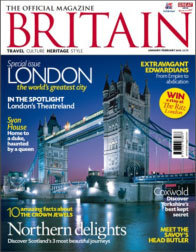
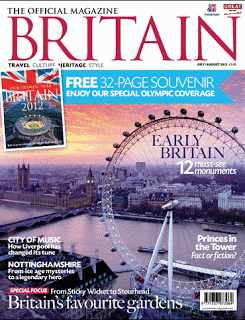
/[image error]
Published on August 04, 2012 01:00
Kristine Hughes's Blog
- Kristine Hughes's profile
- 6 followers
Kristine Hughes isn't a Goodreads Author
(yet),
but they
do have a blog,
so here are some recent posts imported from
their feed.



